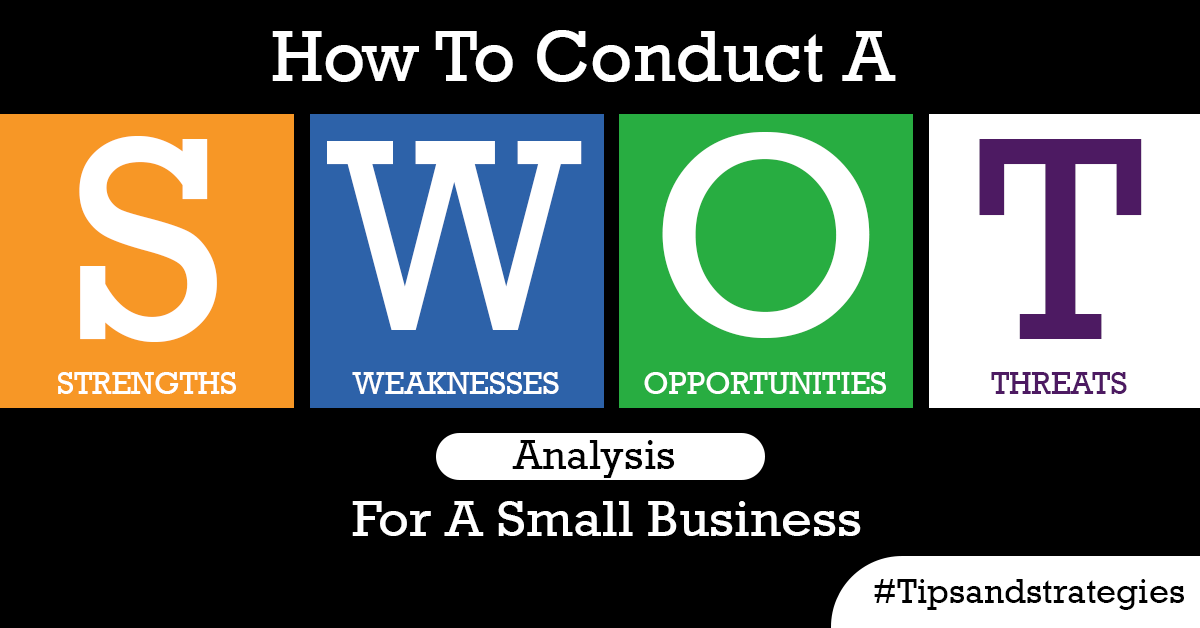
How To Conduct A SWOT Analysis For A Small Business: With the use of a SWOT analysis, a business owner may better understand their strengths and weaknesses as well as potential opportunities and threats in a given circumstance. The most typical application of a SWOT analysis is as part of a marketing strategy, although it may also be useful for general corporate planning and as a springboard for team conversations.EnoughInfo.com

A SWOT analysis may be quite informative when done carefully and be helpful in a variety of circumstances. This post will demonstrate how to perform a SWOT analysis and offer some advice on how to utilise the tool successfully.
S-W-O-T
SWOT stands for Strengths, Weaknesses, Opportunities, and Threats. It is a strategic planning tool used by businesses to assess their internal strengths and weaknesses, as well as external opportunities and threats in the market or business environment. It involves identifying and analyzing these four factors to gain insights into the current state of a business and inform decision-making.
- Strengths: These are the internal factors that give a business an advantage over others. They can include unique selling propositions, strong brand recognition, loyal customer base, skilled workforce, efficient processes, or valuable assets and resources.
- Weaknesses: These are the internal factors that put a business at a disadvantage compared to others. They can include inadequate resources, limited market presence, weak branding, lack of key skills or expertise, or inefficient processes.
- Opportunities: These are the external factors in the market or business environment that a business can potentially leverage to its advantage. They can include changing customer preferences, emerging markets, technological advancements, new business partnerships, or favorable industry trends.
- Threats: These are the external factors in the market or business environment that can potentially harm a business. They can include increasing competition, changing regulations, economic downturns, shifts in consumer behavior, or other obstacles that pose risks to the business’s success.
FAQs & Answers on How To Conduct A SWOT Analysis For A Small Business
1. How often should I conduct a SWOT analysis for my small business?
The frequency of conducting a SWOT analysis for your small business can vary depending on your business’s dynamics and the external environment. It’s recommended to conduct a SWOT analysis at least annually or whenever there are significant changes in your business or market conditions. Regularly reviewing and updating your SWOT analysis can help you stay informed and adapt your strategies accordingly.
2. Should I involve others in my SWOT analysis?
Yes, it’s advisable to involve key stakeholders in your SWOT analysis. This includes business owners, employees, and other relevant parties who can provide diverse perspectives and insights. Involving others can help you gain a broader understanding of your business’s strengths, weaknesses, opportunities, and threats and ensure a more comprehensive analysis.
3. Should I validate the information used in my SWOT analysis?
Yes, it’s important to validate the information used in your SWOT analysis to ensure its credibility and accuracy. Rely on reliable and verified data from reputable sources. Avoid using assumptions or unverified information, as it may lead to inaccurate or incomplete analysis, which can impact the effectiveness of your strategies.
How To Conduct A SWOT Analysis For A Small Business
A SWOT analysis is a strategic planning tool used to assess the strengths, weaknesses, opportunities, and threats of a business. It can help small business owners identify internal strengths and weaknesses, as well as external opportunities and threats in the market. Here’s a step-by-step guide on how to conduct a SWOT analysis for a small business:
1. Define the objective
Start by clearly defining the objective of your SWOT analysis. What are you trying to achieve? Are you looking to assess your overall business performance, evaluate a new product or service, or analyze a specific aspect of your business?
2. Gather information
Collect data and information about your business and its environment. This can include internal factors such as financials, operations, marketing strategies, and human resources, as well as external factors such as market trends, customer feedback, and competitor analysis. How To Blend In Procreate(All You Need to Know)
3. Identify strengths
Identify the strengths of your business. These are the internal factors that give your business an advantage over others. For example, strong brand recognition, a loyal customer base, unique product or service, a skilled workforce, or efficient processes can be strengths of your business.
4. Identify weaknesses
Identify the weaknesses of your business. These are the internal factors that put your business at a disadvantage compared to others. Examples of weaknesses could be a lack of financial resources, limited market presence, weak branding, inadequate skill sets, or inefficient processes.
5. Identify opportunities
Identify the opportunities in the market that your business can leverage. These are the external factors that can potentially benefit your business. For instance, changing customer preferences, emerging markets, technological advancements, or new business partnerships could be opportunities for your business.
6. Identify threats
Identify the threats in the market that your business may face. These are the external factors that can potentially harm your business. Examples of threats could be increasing competition, changing regulations, economic downturns, or shifts in consumer behavior.
7. Analyze and prioritize
Analyze the strengths, weaknesses, opportunities, and threats identified in your SWOT analysis. Prioritize them based on their impact and relevance to your business. Focus on the most critical factors that can have a significant impact on your business’s success or failure.
8. Develop strategies
Based on the insights gained from your SWOT analysis, develop strategies to capitalize on your strengths, address your weaknesses, take advantage of opportunities, and mitigate threats. These strategies can help you make informed decisions and guide your business toward success.
9. Implement and monitor
Implement the strategies developed from your SWOT analysis and monitor their progress over time. Regularly review and update your SWOT analysis to adapt to changes in your business environment and stay ahead of the competition.
What not to do when conducting a SWOT analysis
When conducting a SWOT analysis for a small business, there are some common pitfalls that should be avoided to ensure a meaningful and effective analysis. Here are some things to avoid when conducting a SWOT analysis:
Being too vague or superficial:
It’s important to be specific and thorough when identifying strengths, weaknesses, opportunities, and threats. Avoid general or superficial statements that lack details or specifics. Instead, strive to provide concrete and specific examples that accurately reflect the reality of your small business.
Neglecting to involve key stakeholders:
A SWOT analysis can provide valuable insights, and it’s important to involve key stakeholders in the process. This includes business owners, employees, and other relevant parties who can provide diverse perspectives and insights. Neglecting to involve key stakeholders may result in limited or biased analysis.
Ignoring biases or assumptions:
It’s important to be aware of any biases or assumptions that may influence your SWOT analysis. Be objective and avoid making assumptions without evidence or data to support them. Bias can lead to inaccurate or incomplete analysis, which may result in ineffective strategies.
Overlooking internal weaknesses:
It’s common for businesses to focus on identifying strengths and opportunities, but it’s equally important to identify and address internal weaknesses. Avoid overlooking or downplaying weaknesses, as they can hinder business performance and growth. Be honest and realistic when identifying and analyzing weaknesses.
Neglecting to validate information:
It’s important to base your SWOT analysis on reliable and accurate information. Avoid using unverified or outdated data, as it may result in inaccurate conclusions. Validate information from multiple sources to ensure its credibility and accuracy. How To Season Cast Iron Without Oven
Not prioritizing factors:
Not all strengths, weaknesses, opportunities, and threats are of equal importance or relevance to your business. Avoid treating all factors equally or failing to prioritize them. It’s crucial to prioritize the most critical and impactful factors to guide your strategic decision-making.
Failing to develop strategies:
The purpose of a SWOT analysis is to inform strategic decision-making. Avoid stopping at the analysis stage and failing to develop actionable strategies based on the insights gained. The ultimate goal of a SWOT analysis is to develop strategies that can help address weaknesses, leverage strengths, capitalize on opportunities, and mitigate threats. How To Set And Achieve Meaningful Goals In Life
Conclusion
In Conclusion, By conducting a SWOT analysis, businesses can gain a comprehensive understanding of their internal strengths and weaknesses, as well as external opportunities and threats. This analysis can provide insights that can inform decision-making, help businesses capitalize on their strengths, address their weaknesses, leverage opportunities, and mitigate threats. It is a useful tool for strategic planning, goal setting, and developing effective strategies to achieve business objectives.
Recommended;
How To Write A Literary Analysis( All You Need to Know)




